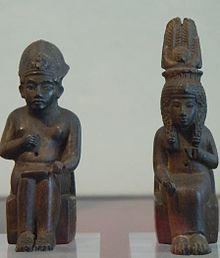Ebony statuettes of Amenhotep III. and his wife Teje
The ebony statuettes of Amenhotep III. and his wife Teje are an example of royal sculptures from the Egyptian collection of the Roemer and Pelizaeus Museum in Hildesheim . The carved figurines come from the 18th Dynasty, New Kingdom around 1350 BC. Chr. (Inventory numbers: PM 53a / 53b).
Location
Wilhelm Pelizaeus acquired the ebony statuettes with remnants of gilding in the Cairo art trade before 1907. They have been in Hildesheim since the donation was made in 1909. They were acquired from Wilhelm Pelizaeus together with the inscribed fragment inventory number: PM53 c (a wooden fragment with the throne name Amenophis III.) And the statuette inventory number: PM54 (statuette of a prince from the time of Amenhotep III / IV.). All objects are believed to come from the same find from Gurob in Fayum in Middle Egypt .
size
The figurine of King Amenhotep III. is 5.8 cm high, 2.4 cm wide and 3.5 cm deep, that of Queen Teje is 6.4 cm high, 1.8 cm wide and 3.3 cm deep.
description
Amenhotep III and his wife Teje sit on simple block thrones with low backs. The thrones are decorated with a fine feather pattern on the sides and lotus flowers on the back . He held a scepter in his right hand , Teje a lotus frond in his left hand; both are lost today. Amenhotep III wears the blue crown and a short pleated apron. Teje is dressed in an ankle-length robe and wears a fine curly wig. A diadem, to which a double uraeus is attached, encloses her forehead. The two small sitting figurines with their conspicuous corpulence and the squat proportions could be described as portraits of old age. The eyes of Teje were originally provided with inlays, in Amenhotep III. they were only painted on. Both figures were gilded and could have served as attachments to ceremonial staffs. In particular, the slightly elongated face shapes, the protruding mouth and nose area and the corpulence of the two figures speak for the production of the works of art after the death of the royal couple in the Amarna period .
literature
- Günther Roeder , Albert Ippel : The monuments of the Pelizaeus Museum in Hildesheim. Curtius, Berlin 1921, pp. 35-36 and pp. 78-79.
- Hans Kayser : The Pelizaeus Museum in Hildesheim . Cram, de Gruyter, Hamburg 1966, p. 28 and 59 (Figure 23. Ebony figurines of King Amenhotep III and his wife Teje).
- Hans Kayser: The Egyptian antiquities in the Roemer-Pelizaeus-Museum in Hildesheim. Gerstenberg, Hildesheim 1973, ISBN 3-8067-8002-1 , p. 70 and Fig. 59.
- Bettina Schmitz : Amenophis III. and Teje . In: Nofret - The Beautiful. The woman in ancient Egypt . "Truth" and Reality. von Zabern, Mainz 1985, ISBN 3-8053-0854-X , p. 80–82 (catalog manual for the exhibition in the Roemer and Pelizaeus Museum Hildesheim July 15 - November 4, 1985, volume 2).
- Arielle P. Kozloff, Betsy Morrell Bryan, Lawrence M. Berman: Egypt's Dazzling Sun: Amenhotep III and his world. Cleveland Museum Of Art 1992, ISBN 0-940717-16-6 , cat. 27.
- Arne Eggebrecht (Ed.): Pelizaeus Museum Hildesheim: The Egyptian Collection. von Zabern, Mainz 1993, ISBN 3-8053-1579-1 , p. 59.
- Martin von Falck: statuettes of Amenophis III. and the Teje . In: Katja Lembke (ed.): Life on the Nile and everyday life in ancient Egypt (= The ancient Egypt in Hildesheim ). tape 2 . von Zabern, Darmstadt / Mainz 2011, ISBN 978-3-8053-4285-8 , p. 60–61 (catalog for the permanent exhibition).
Web links
- Entry at The Global Egyptian Museum
